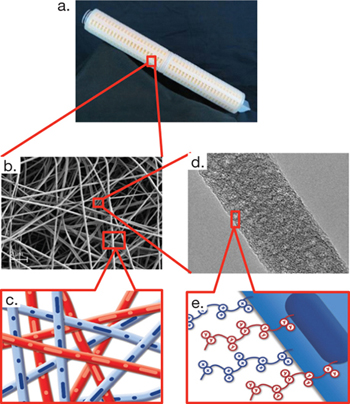Consider two grand challenges of the 21st century cited by the National Academy of Engineering: Provide access to clean water, and engineer better medicines. These seemingly unrelated global challenges share an important issue — the need for a breakthrough technology for low-cost, efficient purifications.

▲ (a) Nanofiber Separations’ purification module is a hybrid mat that can be tailored for specific applications. (b and c) The hybrid mat is composed of overlapping composite nanofibers. (d) Each nanofiber is made of multiple components, and different fibers are assembled within the overall structure to customize the module for a particular application. (e) The fibers are modified by physical and/or chemical treatment to further customize the separation capabilities. The mat can also be produced with different layering schemes and thicknesses.
Inefficient separation systems for removing pathogens and other impurities limit access to therapeutic drugs and safe drinking water. Current purification technologies, such as traditional filters and adsorbent resins, require extensive infrastructure and a series of complex energy- and labor-intensive operations to meet acceptable purity specifications, which increase costs and reduce production volumes. That is about to change.
With funding from the National Science Foundation, Nanofiber Separations, LLC, a company spun out from the South Dakota School of Mines and Technology in Rapid City, SD, now produces electrospun nano fiber-based membranes that accomplish difficult purifications within a single module. The company’s patent-pending technology combines innovative composite fibers, hybrid mats, and specialty treatments to create a unique separation medium capable of both size-based as well as adsorptive separation mechanisms. Unlike generic single-component nanofiber mats, these separation media can be easily tailored for applications that involve complex feed streams, which are routinely seen in pharmaceutical processing and water purification.
The new filters simultaneously provide high selectivity, ultrahigh capacity, and long service life, without compromising high-flux, low-pressure operation. The filters also have low energy requirements, do not need to be replaced or cleaned frequently, and generate minimal waste.
Nanofiber Separations has developed customized materials that perform significantly better than standard commercial media in a variety of applications. For example, in the biopharmaceutical industry, where the downstream purification operations can account for over 75% of the total processing expenses, the new materials have a dynamic adsorption capacity that is more than eight times higher than that of commercially available alternatives and a permeability that is more than double. Techno economic modeling has shown that these performance advantages can reduce total purification costs by an estimated 15–25%, and simultaneously increase throughput by about 18–30%, reducing the need for additional manufacturing space and capital investment. As an additional benefit, the off-the-shelf installation reduces validation and operational risks.
“The attributes of the material are all highly desirable within any biopharmaceutical manufacturing process and allow for opportunities beyond what current technologies provide,” says Jennifer McNay, Executive Director of Industrial Operations and Product Supply at Regeneron Pharmaceuticals, Inc.
Similarly, Nanofiber Separations has developed separation devices for water purification that can remove multiple impurities within a single module and provide elevated flux. Those filters have very low (or even no) energy requirements — estimated to be as much as 30% lower than those of other filtration devices.
“Nanofiber Separations’ materials would introduce new capabilities for individual and small-scale water treatment products, which are not being met by the current generation of membranes,” says Tim Oriard, Principal Scientist at Cascade Designs, Inc.
The company is currently expanding manufacturing capacity for its innovative materials and is actively working with customers and partners to create full-scale separation devices for pharmaceutical and point-of-use and point-of-entry water purification. It is also optimizing its manufacturing process to provide consistent, efficient, and economic production of several hundred m2/day of nano fiber sheets.
This article was prepared by the National Science Foundation in partnership with CEP.

Copyright Permissions
Would you like to reuse content from CEP Magazine? It’s easy to request permission to reuse content. Simply click here to connect instantly to licensing services, where you can choose from a list of options regarding how you would like to reuse the desired content and complete the transaction.
